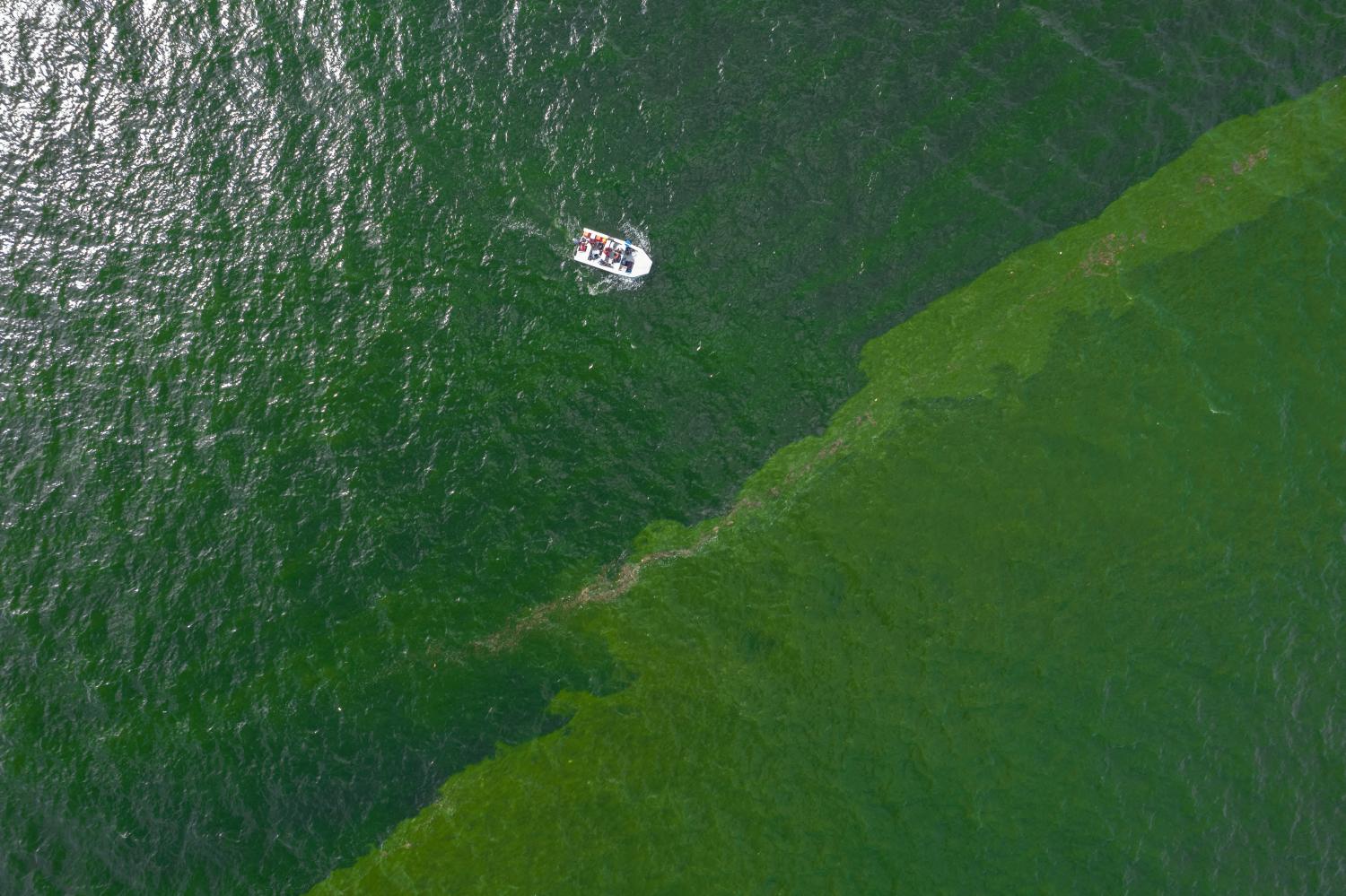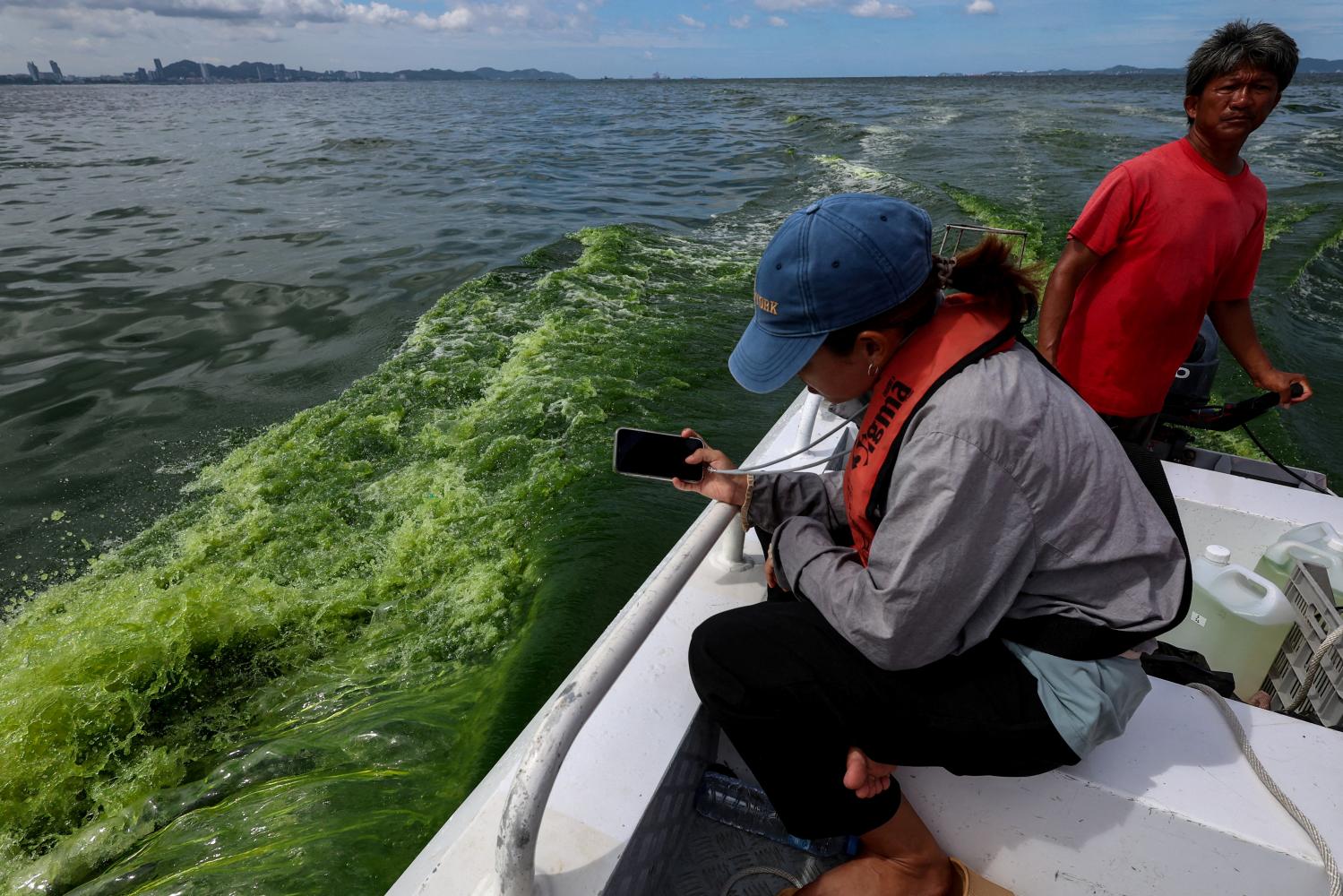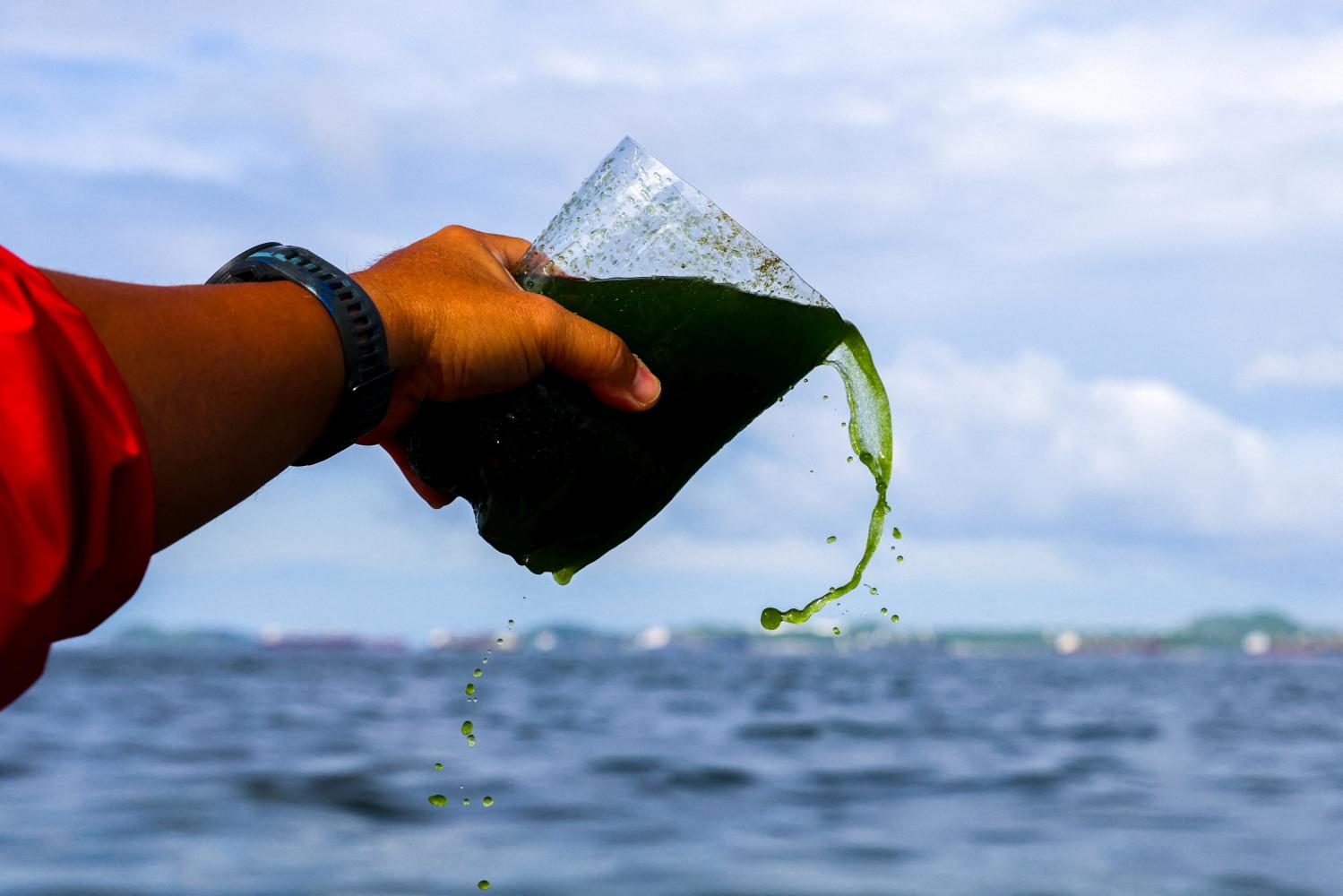Last month, thousands of dead fish were reported to have washed ashore on Bang Saen beach in Chon Buri. An environmental academician declared that the fish died due to a lack of oxygen caused by a plankton bloom.

An aerial view of a plankton bloom off the Chon Buri coastline on Sept 14. Photo: Napat Wesshasartar / REUTERS
To raise awareness of this environmental issue, the Office of Innovation and Social Mission collaborated with the Faculty of Fisheries at Kasetsart University (KU) to organise a forum titled “The Green Ocean Is More Hazardous Than We Think”.
Prof Shettapong Meksumpun, a lecturer at the Department of Marine Science at the Faculty of Fisheries, KU, explained that plankton blooms have been around for years. In the past, fishermen referred to it as whale waste; it only remained for a short time and then disappeared. However, now there are more plankton blooms than before and they seem to remain in the seawater for a longer period of time.
“Now, plankton blooms last for two weeks and disappear for one week and then they are back again. In the past, they occurred seasonally. During the rainy season, they occurred in Bang Saen, while in the winter, they could be found in western areas such as Prachuap Khiri Khan and Phetchaburi. Nowadays, we can see plankton blooms almost every day, but they occur in different areas. Phytoplankton releases oxygen during the day, but at night, it consumes oxygen. This causes fish to die,” said Prof Shettapong.
The primary concern people have about plankton blooms is whether they are harmful to humans.
“Plankton blooms can appear in various colours, such as brown, rust, violet or red. Although they are dangerous for marine life, they are not harmful for people. However, it is advisable to avoid swimming in green oceans because some people may unknowingly be allergic. Also, it is recommended to refrain from drinking seawater since planktons absorb various nutrients including bacteria. It is safe to eat aquatic animals from this area, provided they are not rotten and thoroughly cooked,” explained Prof Shettapong.

A marine scientist from Kasetsart University works off the Chon Buri coastline on Sept 14. Photos: Athit Perawongmetha / REUTERS
“One of my PhD students conducted research on plankton blooms and found that some of the fish we consume contains low levels of amnesic shellfish poison. This indicates that there are now phytoplankton capable of producing toxins in Thailand’s oceans. The harmful phytoplankton await the right conditions to bloom. This has put us in a crisis. I am deeply concerned about it,” he added.
The Tua Kor area of the Gulf of Thailand often experiences plankton blooms due to the gulf’s basin-like shape, which can obstruct water flow. The main rivers that discharge water into the Gulf of Thailand include the Chao Phraya, Bang Pakong, Tha Chin and Mae Klong. The Chao Phraya carries the highest levels of phosphorus and nitrate. As a result, the Gulf of Thailand experiences eutrophication, which is an overabundance of nutrients. The nutrient levels have increased by 1.5 times over the past 30 years.
The recent plankton bloom expansion occurred at the same time as an oil spill off the coast of Sri Racha. This led people to question if there was a connection between the plankton bloom and the oil spill. Chaiyuth Sanghaisuk, the director of the Pollution Control Department (PCD), explained that in this case, there is no evidence to indicate that the two incidents are related.
“After dispersants were used to clean up the oil spill, some people also questioned whether the dispersants were the cause of the plankton blooms. Dispersants are safe and are not factors that can cause plankton bloom,” said Chaiyuth.
Asst Prof Thon Thamrongnawasawat, deputy dean of the Department of Marine Science at the Faculty of Fisheries, KU, said the Tua Kor area is like a ticking time bomb ready to blow up. Whenever the conditions are right, plankton blooms will multiply since the area is affected by eutrophication.
Plankton can occur naturally, but Pinsak Suraswadi, the director-general of the PCD, referred to the current blooms as “novel entities” caused by humans. He explained that green oceans are one of the triple planetary crises — the other two being climate change and biodiversity loss and pollution. Green oceans fall under the category of pollution.

Photo: Athit Perawongmetha / REUTERS
“There are three main sources of polluted waters — wastewater from communities, from industries and from agriculture. These polluted waters are not purified before being released into the oceans, although some do undergo water treatment. Communities lack wastewater management and treatment. Cleaning up wastewater incurs expenses. Similar to garbage collection fees, collecting wastewater management fees from community members is difficult,” said Pinsak.
“There are other ways to encourage people to manage wastewater treatment systems. In Chiang Mai, Klong Mae Kha improved its wastewater treatment system and underwent a landscape redevelopment. This helped people in the area earn income from tourists. As for factories, there are other actions that can be taken to treat wastewater. For example, a brewery often has excess yeast, which a golf club may want to use as a nutrient for its plants. Additionally, the PCD will establish subcommittees to specifically manage nutrients loading in oceans.”
Supported by the National Water and Climate Data Center, GOT 001 Station is a marine monitoring system collecting data on seawater at KU’s Sriracha Fisheries Research Station every five minutes. Tanuspong Pokavanich, a lecturer at KU, explained that this technology can monitor the temperature of seawater, the quality of freshwater and saltwater, wind power, oxygen and plankton blooms.
To prevent the green ocean issue, Sumana Kajonwattanakul, director of the Marine and Coastal Resources Research and Development Institute at the Department of Marine and Coastal Resources, suggested academicians cooperate and share their studies. She commented that most academicians work separately, so their knowledge is not shared and connected. After gaining extensive information about green oceans, the Department of Marine and Coastal Resources will send information to policymakers.
Chaiyuth commented that the solution to addressing the issue of green oceans relies on cooperation and awareness from all sectors. It is like having a meal — everyone should finish everything on their plate, so there is no waste.
“Business owners should have a social conscience when it comes to discharging wastewater. Fishermen who raise fish and shellfish should provide sufficient food and avoiding overfeeding,” said Chaiyuth.
Asst Prof Thon said policymakers usually mention the sustainable development goals policy, but management of green oceans is not given much attention. During the forum, the PCD revealed that there are only 14 officers in charge of Thailand’s oceans. The Department of Marine and Coastal Resources’ budget was also cut, so it had to reduce marine surveys from four times a year to twice a year.
“Since plankton that contains toxins are now present in Thai waters, I am really concerned. Government agencies involved in this matter should allot budget to the PCD and Department of Marine and Coastal Resources to handle the issue,” concluded Asst Prof Thon.


